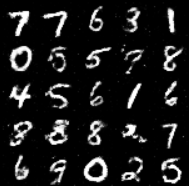自己修改了github的代码,选取了比较核心的代码,简化了相关操作
基于MNIST数据集
# 库的引用
import torch
import torch.nn as nn
import torch.nn.functional as F
import numpy
from torchvision import datasets
from torch.utils.data import DataLoader
from torchvision import transforms
from torch.autograd import Variable
from torchvision.utils import save_image
# 用到的参数及设置
batch_size = 128
lr = 0.0002
train_epoch = 50
transform = transforms.Compose([transforms.ToTensor(), transforms.Normalize([0.5], [0.5])])
# device = torch.device('cuda:0' if torch.cuda.is_available() else 'cpu')
# 准备数据
data = datasets.MNIST(root='./data/mnist', train=True, transform=transform, download=True)
data_loader = DataLoader(data, batch_size=batch_size, shuffle=True, num_workers=4)
def normal_init(m, mean, std):
if isinstance(m, nn.Linear):
m.weight.data.normal_(mean, std)
m.bias.data.zero_()
class Generator(nn.Module):
def __init__(self):
super(Generator, self).__init__()
self.fc1_1 = nn.Linear(100, 256) # 100是噪声的维度
self.fc1_1_bn = nn.BatchNorm1d(256)
self.fc1_2 = nn.Linear(10, 256)
self.fc1_2_bn = nn.BatchNorm1d(256)
self.fc2 = nn.Linear(512, 512)
self.fc2_bn = nn.BatchNorm1d(512)
self.fc3 = nn.Linear(512, 1024)
self.fc3_bn = nn.BatchNorm1d(1024)
self.fc4 = nn.Linear(1024, 784)
# 循环时字典遍历的是key
def weight_init(self, mean, std):
for m in self._modules:
normal_init(self._modules[m], mean, std)
def forward(self, input, label):
batch_size = input.size(0)
x = F.relu(self.fc1_1_bn(self.fc1_1(input)))
y = F.relu(self.fc1_2_bn(self.fc1_2(label)))
x = torch.cat([x, y], 1) # 这样就变为512维了
x = F.relu(self.fc2_bn(self.fc2(x)))
x = F.relu(self.fc3_bn(self.fc3(x)))
x = torch.tanh(self.fc4(x))
# 可以reshape为图片的维度
gen_img = x.view(batch_size, 1, 28, 28)
return gen_img
class Discriminator(nn.Module):
def __init__(self):
super(Discriminator, self).__init__()
self.fc1_1 = nn.Linear(784, 1024)
self.fc1_2 = nn.Linear(10, 1024)
self.fc2 = nn.Linear(2048, 512)
self.fc2_bn = nn.BatchNorm1d(512)
self.fc3 = nn.Linear(512, 256)
self.fc3_bn = nn.BatchNorm1d(256)
self.fc4 = nn.Linear(256, 1)
def weight_init(self, mean, std):
for m in self._modules:
normal_init(self._modules[m], mean, std)
def forward(self, input, label):
# Flatten操作,展平为784个像素后再操作
batch_size = input.shape[0]
x = input.view(batch_size, -1)
x = F.leaky_relu(self.fc1_1(x), 0.2)
y = F.leaky_relu(self.fc1_2(label), 0.2)
x = torch.cat([x, y], 1) # 按列进行连接,变为2048维
x = F.leaky_relu(self.fc2_bn(self.fc2(x)), 0.2)
x = F.leaky_relu(self.fc3_bn(self.fc3(x)), 0.2)
x = torch.sigmoid(self.fc4(x))
return x
# network,结构可以参照图片
G = Generator().cuda()
D = Discriminator().cuda()
G.weight_init(mean=0, std=0.02)
D.weight_init(mean=0, std=0.02)
criterion = nn.BCELoss()
G_optimizer = torch.optim.Adam(G.parameters(), lr=lr, betas=(0.5, 0.999))
D_optimizer = torch.optim.Adam(D.parameters(), lr=lr, betas=(0.5, 0.999))
def train(epoch):
# 随着训练进行, 让lr变小
if (epoch+1) == 30:
G_optimizer.param_groups[0]['lr'] /= 10
D_optimizer.param_groups[0]['lr'] /= 10
print("learning rate change!")
if (epoch+1) == 40:
G_optimizer.param_groups[0]['lr'] /= 10
D_optimizer.param_groups[0]['lr'] /= 10
print("learning rate change!")
for ind, (images, labels) in enumerate(data_loader):
# 随机噪声z,100维
z = Variable(torch.Tensor(numpy.random.normal(0, 1, (images.size(0), 100))))
# train discriminator D
mini_batch = images.size(0)
D.zero_grad()
#这是对应的二分类真与假的标签值
y_real_ = torch.ones(mini_batch)
y_fake_ = torch.zeros(mini_batch)
# 这两句是生成label的one-hot向量,因为bceloss用的是one-hot
y_label_ = torch.zeros(mini_batch, 10)
y_label_.scatter_(1, labels.view(mini_batch, 1), 1)
# (128,10)
images, y_label_, y_real_, y_fake_ = Variable(images.cuda()), Variable(y_label_.cuda()), Variable(\
y_real_.cuda()), Variable(y_fake_.cuda())
D_result = D(images, y_label_).squeeze() # 这是告诉判别器标签和图片的配对情况
# 这个地方suqeeze就是128, 不是就是(128,1), 不能BCEloss
D_real_loss = criterion(D_result, y_real_) # Discriminator的一个loss
y_ = (torch.rand(mini_batch, 1) * 10).type(torch.LongTensor)
y_label_ = torch.zeros(mini_batch, 10)
y_label_.scatter_(1, y_.view(mini_batch, 1), 1)
z, y_label_ = Variable(z.cuda()), Variable(y_label_.cuda())
G_result = G(z, y_label_)
gen_imgs = G(z, y_label_)
D_result = D(G_result, y_label_).squeeze()
D_fake_loss = criterion(D_result, y_fake_) # Discriminator的假图片loss
D_train_loss = D_real_loss + D_fake_loss
D_train_loss.backward()
D_optimizer.step()
# train generator G
G.zero_grad()
# 杂乱的生成的标签
z_ = torch.rand((mini_batch, 100))
y_ = (torch.rand(mini_batch, 1) * 10).type(torch.LongTensor)
y_label_ = torch.zeros(mini_batch, 10)
y_label_.scatter_(1, y_.view(mini_batch, 1), 1)
z_, y_label_ = Variable(z_.cuda()), Variable(y_label_.cuda())
G_result = G(z_, y_label_)
D_result = D(G_result, y_label_).squeeze()
G_train_loss = criterion(D_result, y_real_)
G_train_loss.backward()
G_optimizer.step()
if ind % 50 == 0:
print('G_loss:', G_train_loss.data.item(), 'D_loss:', D_train_loss.data.item())
save_image(gen_imgs.data[:25], 'images{}.png'.format(epoch), nrow=5, normalize=True)
if __name__ == '__main__':
for epoch in range(train_epoch):
train(epoch)
结果如图,效果还是不错的

























 1万+
1万+











 被折叠的 条评论
为什么被折叠?
被折叠的 条评论
为什么被折叠?










